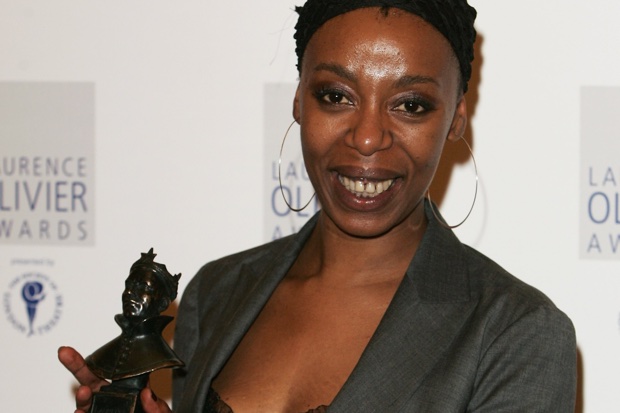There’s nothing confusing about a black actress playing Hermione Granger
written for The Spectator, 21st December 2015

Noma Dumezweni winning a Laurence Olivier Award for Best Performance in a Supporting Role for A Raisin in the Sun (Photo credit: Getty)
A news producer rang up this morning, asking me to talk about ‘colour-blind casting’. Noma Dumezweni has just been cast as Hermione in Harry Potter and the Cursed Child, the stage sequel to JK Rowling’s novels. So there I was, listening to a hack ask ‘isn’t it confusing when black actresses play white roles?’ When I was too stunned to answer, he added, encouragingly, ‘we thought you’d be happy to come on and criticise Sonia Friedman’.
True, if you follow theatre, you’ll know that Sonia Friedman, the super-producer who brings Hollywood’s most commercial franchises to the West End stage, won’t be sending me a Christmas card this year. But for very different reasons. Friedman knows how to pack her houses, and when she brought Benedict Cumberbatch to the Barbican in this year’s Hamlet, I described the cinematic result as ‘a production cut to frame its star’. Scott Jordan Harris identified ‘the carefully choreographed theatrical re-creation of the trademark moments in Sherlock,’ Cumberbatch’s iconic TV series. This could have been an opportunity for theatre to challenge and engage a new audience: instead, it merely monetised an existing fanbase.
That’s always the concern when an iconic actor returns to the stage, or conversely, when a successful film franchise comes to the theatre. We’ve all been wondering what Sonia Friedman would do to Harry Potter, and the omens didn’t always look good. Harry Potter and the Cursed Child hits the Palace Theatre in July of next year, and one of the earliest announcements revealed that it has been spread over two separate plays, meaning fans have to buy two tickets to ensure they get the full story. Move over Hunger Games: Mocking Jay Parts 1 & 2: when it comes to milking cash-cows, you’ve nothing on Sonia.
So if you were looking for a friendly showbiz hack to gush about Friedman’s latest casting news, you shouldn’t be looking here. But here’s my honest assessment: the casting of Noma Dumezweni as Hermione Granger in the forthcoming Harry Potter and the Cursed Child is inspired. And it reminds us that the play’s director, longstanding Friedman associate John Tiffany, understands something vital about theatre.
As everyone capable of a glance at Twitter knows, Dumezweni is black. A minor point that seems to have been lost is that she’s also an actress who consistently engages and enthrals. She’s no newcomer, winning an Olivier award for A Raisin In The Sun in 2006, and stepping in to replace Kim Cattrall last month in Linda at the Royal Court. Last year, in A Human Being Died That Night, she brought a brittle dignity to the role of Pumla Gobodo-Madikizela, a human rights investigator in Dumezweni’s native South Africa.
But yes, her colour matters. Not just if you’re a well-meaning type who thinks that diversity on stage is nice and that black actresses should have a chance at meatier roles. It matters, to anyone who cares about theatre, because it’s a sign that Tiffany isn’t just trying to recreate the movie on stage.
Theatre is the most adaptive, fluid and flexible of the narrative arts. We take old stories, and make them speak to new eras, new audiences. JK Rowling tweeted this morning that she’d never specified Hermione’s skin colour in the books, which is well-intentioned, but shouldn’t matter. The race of the historical Cleopatra is fiercely contested, but actresses of all races and nations have taken Shakespeare’s version of her and created something new. Hermione won’t always belong to JK Rowling. She certainly doesn’t belong to Emma Watson.
In Dumezweni’s current role, she didn’t just step into Kim Cattrall’s shoes. She made it her own. Linda is a portrayal of a woman in her mid-fifties, suddenly confronted with the realities of ageing, of redundant motherhood, of the decaying female body. There’s a moment, towards the end, when Dumezweni lifts her hand to her luscious hair, and suddenly, a wig is stripped away, revealing short, knotted whisps. Reminiscent of Viola Davis in How To Get Away With Murder, it’s a moment that makes visible the specific anxieties of black women’s relationship with their hair. But it also speaks to every woman, of any age or race, who has a beauty secret to hide. It could never have happened with Kim Cattrall.
As I’ve written before, the casting of black actors in ‘white’ roles doesn’t distract from any reality being portrayed on stage (remember the old ‘suspension of disbelief’?) But it can enrich it, adding new questions, new concerns. A black, forty-six year old Hermione will add new resonances to a mythic story, if we choose to see it. Such is the essence of theatre’s mutability. So trust me on this. Harry Potter and the Cursed Child is something about which even the most curmudgeonly of theatre critics should be excited. It’s adaptive, it’s alive. Even if I still don’t think I’m going to be grabbing cocktails with Sonia Friedman any time soon.






